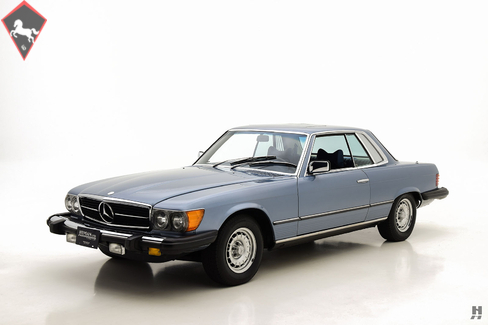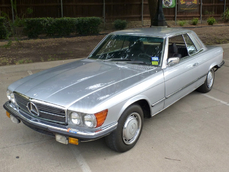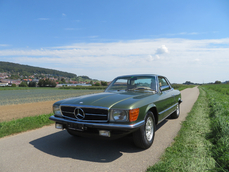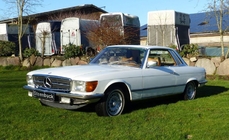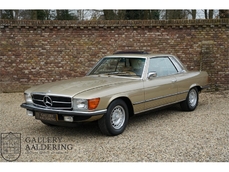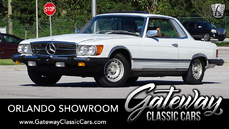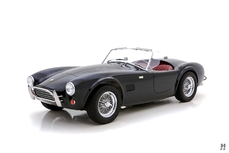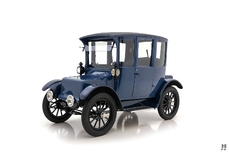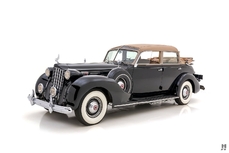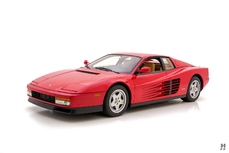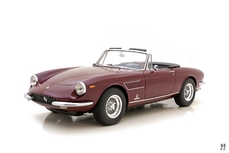Mercedes-Benz 450SLC w107 Coupe 1979
General description :
Following up on the commercial success of the R113-series 230, 250 and 280SL, Mercedes-Benz unveiled the all-new and thoroughly modern R107-series in 1971. The 107 continued along the path forged by the R113 that set the foundation of the SL-class as we know it today. The R113 was the car that took the engineering excellence of the original 300SL and combined it with the broader market appeal of the junior 190SL, in a package that was sporty, civilized and exceptionally well-rounded. The SL was now a sports car for those who preferred to arrive in style yet remain completely unruffled, an ethos that remains in the DNA of today’s SL roadsters.
Introduced in late 1971, the R107 further refined the theme set forth by the R113, albeit on an all-new platform that was larger, more rigid, and wrapped in finely detailed styling. It was also the first new model to benefit fully from Mercedes’ obsession with safety that began in the late 1960s. From its introduction, it was designed to carry both six-cylinder and a new line V8 engines. Suspension was fully independent all around, backed by four wheel disc brakes and a robust unibody chassis. Alongside the traditional roadster with its optional removable hard top, Mercedes-Benz also unveiled a full four seat version with a fixed roof and extended wheelbase. This new model, dubbed “SLC” replaced the ageing W111-based 280SE and marked the first time their flagship four-seat coupe was based not on a sedan platform, but the sporting SL platform. The SLC shared the same suspension, braking and powertrain components as its open-topped sibling, but benefitted from an exceptionally rigid platform with the fixed roof. Combined with the longer wheelbase, and the larger 4.5 liter version of the alloy V8, the SLC delivered robust performance and exceptional ride quality. Typical for a Mercedes-Benz SL-class car, the SLC was tuned for high-speed touring rather than outright corner-carving ability. But in spite of its grand touring pretenses and soft-sprung nature, the SLC was quite a capable sporting car – with predictable handling, excellent grip and powerful brakes. In fact, the SLC became a rather successful (albeit unlikely) rally competitor through the 1970s and into the 1980s. The 107 platform was such a success that it became the longest running passenger car model in Mercedes history (only being outlasted by the G-Wagen off-roader) and has become a favorite among collectors and enthusiasts the world over, thanks to its exceptional longevity, timeless style and tank-like build quality.
This 1979 Mercedes-Benz 450SLC is a beautiful, unrestored example showing a genuine 31,354 miles from new. It is finished in its original shade of Gray-Blau metallic (code 906G) over a blue interior and presents in stunning condition inside and out. It is a well-optioned model with factory fitted sunroof, power locks and windows, automatic climate control, Tempomat cruise control and alloy wheels. The body is exceptionally straight, with all original belt moldings, rocker moldings and bumpers in excellent order. Chrome and anodized brightwork is outstanding, with no dings, dents or corrosion to speak of. The SLC’s signature quarter-louvers are in excellent order as well and all original glass is in place. Shut lines are to factory standards, the doors close with vault-like precision, and this car shows no evidence of any prior corrosion or accident damage. It rides on a set of Mercedes’ iconic Bundt alloy wheels in fabulous condition, wrapped in appropriate Pirelli P3000 blackwall radials, delivering the ideal balance of touring comfort and handling prowess. Original lamps, lenses, and the factory-fitted fog lamps all appear in excellent order. This is one of the finest of its kind we have had the pleasure to offer, a truly beautiful example that captures the understated elegance of this oft under-appreciated model.
Inside is more of the same; exceptionally well-preserved original materials and finishes presented in beautiful order. The blue upholstery shows hardly any signs of use, appearing more like a two year old car rather than 38 years old. The driver’s seat is barely broken in, while the passenger and rear seats appear factory fresh. Blue velour carpets are in excellent order, again appearing virtually factory fresh and unsullied, with original MB Star logo overmats. The center console is adorned with beautiful burlwood trim, which repeats on a narrow strip across the dash. Typically a trouble spot on these models, this example appears in beautiful condition with no cracking, crazing or lifting of the veneer. Original HVAC controls appear in excellent order and even the original Becker Mexico Cassette remains in its rightful place in the dash. Instruments, switches and controls are all factory original and in lovely original condition. Even the trunk appears in showroom fresh condition. Lifting the original carpeted panel reveals an untouched spare wheel with original Michelin spare tire, complete with the original tag pertaining to the alloy wheel fitment. A tool roll containing beautiful, unused factory tools is included, as well as the original jack and even the safety triangle. Also included is a comprehensive array of original factory literature, books, and manuals covering all aspects of the car’s operation, many of which appear untouched since new.
The engine bay is similarly exceptional, with original finishes, markings and decals all in place as one would expect from a pampered 32,000 mile example. The original gold cadmium plating remains bright, correct hose clamps are fitted and the entire engine bay is tidy and clean, without appearing to have been restored or excessively detailed. While the 450 SLC’s open-topped sibling may be the more well-known, enthusiasts know that the SLC is far rarer, and finely preserved examples such as this are exceptionally scarce. Finished in timeless colors and presented in beautiful condition from top to bottom, this 450 SLC surely is one of the best-preserved examples of its type.
https://hymanltd.com/vehicles/5956
1979 Mercedes-Benz 450SLC w107 Coupe is listed sold on ClassicDigest in St. Louis by Mark Hyman for $52500.
Car Facts
Car type : Car Make : Mercedes-Benz Model : 450SLC w107 Model Version : Coupe Engine size : 0.0 Model Year : 1979 Sub type : Coupé Location : Missouri
Sold
Seller Information
Sold
People who viewed this Mercedes-Benz 450SLC w107 also viewed similar Mercedes-Benz listed at ClassicDigest
Other cars listed for sale by this dealer
About Mercedes-Benz
In the annals of automotive history, the journey of Mercedes-Benz is a tale that unfolds with the ingenuity of its founding pioneers. In the year 1886, Karl Benz crafted the Benz Patent Motorwagen, a creation that would go down in history as the world's inaugural automobile. Unbeknownst to him, this moment marked the genesis of what would evolve into the most illustrious premium car manufacturer globally. The financial underpinning of this pioneering venture, interestingly, was provided by Karl Benz's wife, Bertha Benz, demonstrating a remarkable partnership that would set the tone for Mercedes-Benz's legacy.A parallel narrative emerged not far away, as Daimler-Motoren-Gesellschaft, founded by Gottlieb Daimler and Wilhelm Maybach, entered the scene. In 1901, they unveiled their automobile under the now-famous moniker "Mercedes," meaning "godsend" in Spanish. This name was bestowed upon the car at the behest of Emil Jellinek's daughter, the distributor for Daimler-Motoren-Gesellschaft. The wheels of innovation were set in motion.
Fast forward to 1926, a pivotal year that witnessed the merger of Daimler with Benz & Cie., culminating in the birth of Daimler-Benz. The amalgamation saw the adoption of "Mercedes-Benz" as the distinguished trademark for their automobiles, fusing the legacies of two visionary entities into one.
Contrary to perceptions of conservatism, the trajectory of Daimler-Benz unfolds as a chronicle of industry firsts. From the introduction of the honeycomb radiator to the float carburetor, and the pioneering implementation of four-wheel brakes in 1924, Daimler-Benz consistently pushed the boundaries of automotive innovation. The diesel-powered Mercedes-Benz 260 D in 1936 marked the inception of diesel engines in passenger cars. The iconic Mercedes-Benz 300SL Gullwing made history as the first car with direct fuel injection, albeit the Gutbrod's tiny 2-stroke engine can claim precedence.
Safety innovations became a hallmark, with Béla Barényi's patented safety cell design in the "Ponton"-models in 1951, featuring front and rear crumple zones. The W116 450SEL 6.9 saw the introduction of the Anti-Lock Brake system (ABS), another pioneering safety feature. From the first production airbags and beyond, the legacy of "firsts" continued to be etched into the fabric of Daimler-Benz.
Over its centennial journey, Mercedes-Benz has not merely produced cars but has sculpted automotive icons. The SSKL, 710 SSK Trossi Roadster, 770K Grosser, 540K Spezial Roadster, 300SL Gullwing, w100 600 Pullman, w111 280SE 3.5 Flachkühler, w113 230SL Pagoda, w109 300 SEL 6.3, and w201 2.3-16 Cosworth stand testament to the brand's commitment to engineering excellence.
The roaring Silver Arrows, or "Silberpfeile," including the W 25, W 125, W154, W165, and W196, created a legacy of dominance on the racetrack. These machines were not merely cars; they were expressions of precision, speed, and an indomitable spirit that left their competitors in the dust.
As Mercedes-Benz marches into the future, it does so not just as an automaker but as a custodian of a legacy, a torchbearer of innovation, and a beacon of automotive excellence. The road ahead is sure to witness the continued fusion of cutting-edge technology, timeless design, and an unwavering commitment to setting new standards in the world of automobiles.
One luminary figure who left an indelible mark was Béla Barényi, often heralded as the "father of passive safety" for his pioneering work in safety engineering. His patented safety cell design, featuring front and rear crumple zones, became a hallmark of Mercedes-Benz's commitment to occupant safety, setting new standards that reverberated throughout the automotive world.
Moving through the chronicles, the collaborative genius of Wilhelm Maybach, alongside Gottlieb Daimler, laid the foundation for Daimler-Motoren-Gesellschaft. Their innovations not only birthed the first Mercedes but established a culture of relentless pursuit of technological excellence that remains integral to Mercedes-Benz's DNA.
In the post-merger era of 1926, Ferdinand Porsche emerged as a prominent figure within Mercedes-Benz. His work on the Mercedes-Benz S-Type, a supercharged race car, garnered acclaim and set the stage for a legacy that extended far beyond the marque. Porsche's impact would later extend to his eponymous company, but his influence at Mercedes-Benz during those formative years was pivotal.
As the 20th century progressed, the legendary Rudolf Uhlenhaut emerged as a key figure. Uhlenhaut, an accomplished engineer and the driving force behind the iconic Silver Arrows, played a crucial role in Mercedes-Benz's dominance in motorsports. His engineering prowess and attention to detail were instrumental in creating some of the most formidable racing cars of the era.
In the latter half of the century, figures like Bruno Sacco, the head of design at Mercedes-Benz from 1975 to 1999, left an indelible imprint on the brand's aesthetic identity. Sacco's design philosophy, characterized by clean lines and timeless elegance, shaped iconic models like the W126 S-Class and the W201 190E, solidifying Mercedes-Benz's reputation for luxury and sophistication.
The narrative would be incomplete without acknowledging the contributions of engineers like Hans Scherenberg, whose leadership in the 1970s ushered in a new era of technological innovation at Mercedes-Benz. Scherenberg's tenure saw the development of groundbreaking technologies, including the Anti-Lock Brake system (ABS) and the introduction of airbags in production cars.
